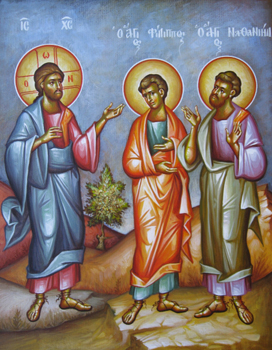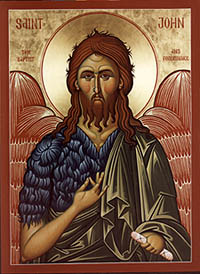For Sunday January 19, 2020
Lectionary Readings (Revised Common Lectionary, Year A)
Isaiah 49:1-7
Psalm 40:1-11
1 Corinthians 1:1-9
John 1:29-42
Our Gospel reading this week is drenched in the language of looking and seeing. “I saw the Spirit,” John says after a dove descends on the newly baptized Jesus. And again: “I myself have seen and have testified.”
“Look, here is the Lamb of God!” he tells his disciples the next day. Jesus “turns and sees” those same disciples, and invites them to “come and see” where he’s staying. Later, Andrew tells his brother Simon that he has “found” the Messiah. The passage ends with Jesus looking at Simon before renaming him.
Looking. Seeing. Finding. Our lectionary revolves around these actions. The Gospel opens as John the Baptizer sees, testifies, and humbly allows his disciples to leave so that they can follow Jesus. Jesus then invites those same disciples to keep looking (“come and see”). But first he asks them a zinger question about seeing, a question we would do well to ask ourselves: “What are you looking for?”
It’s the first recorded question Jesus asks his disciples, and I believe it’s a question for the ages. What are you looking for? In your heart, in your secret and quiet places, what are the hungers that drive you forward in your life of faith? Why do you still have skin in this game we call Christianity? As you say goodbye to an old year and welcome a new one, what are you hoping for, asking for, looking for, in your spiritual life? Do you know?
I’ve been mulling over this question all week. When I go to church, when I pray, when I open the pages of Scripture, what am I looking for? Am I looking for anything, or am I just going through the motions of a religious life I inherited from my parents? Am I seeking consolation? Affirmation? Belonging? Certainty? Am I looking to gain power, or to surrender it? Do I want to know, or can I consent to trust? Am I looking to arrive, or to journey?
 |
I suppose it’s no surprise that the disciples who first hear the question simply dodge it. Perhaps, like us, they don’t quite know what to say. Whatever the case, instead of attempting a response, they ask Jesus their own question: “Where are you staying?” Which I take to mean: where exactly are you headed, Rabbi? Where and how and with whom are you aligned? What will home look like if we hang out with you? What’s our final destination as your potential followers? Tell us up front what we need to know so that we can pin you down, locate you, understand you.
Jesus’s response? A maddening one, concrete and elusive at the same time. “Come and see.” Which is to say: we have to follow Jesus all the way home if we want to know where he is and what he’s about. He won’t be pinned down. He won’t fit into any box we try to stick him in. He's not the type who remains in stasis — he moves. At times, he will not be easy to seek or find. In short: the path that leads to him will become clear only when we decide to walk it. Hence the question we must ask ourselves at every turn: what are we looking for? Jesus? Or something else?
Looking. Seeing. Finding. These are the things we are called to do, not once, but over and over again as Christians. This is the heart of discipleship – not to hasten the end our search, but to pursue it ever more deeply and intentionally. To cultivate a willingness to look. A willingness to see and be seen. A willingness to tell the truth about what we have found. A willingness to venture forth again, even when we don’t know where “home” is.
The invitation to “come and see” is an invitation to leave our comfortable vantage points, and dare to believe that just maybe, we have been limited and wrong in our certainties about each other, about God, and about the world. To “come and see” is to approach all of life with a grace-filled curiosity, to believe that we are holy mysteries to each other, worthy of further exploration. To come and see is to enter into the joy of being deeply seen and deeply known, and to have the very best that lies hidden within us called out and called forth.
 |
Of course, seeing is always selective. We have choices when it comes to what we look for, what we prioritize, what we name, and what we call out in each other. The selves we present to the world are layered and messy, and it takes both love and patience to sift through those layers and find what lies at the core. But there is great power in that sifting, too. Something healing and holy happens to us when we are deeply seen, known, named, and accepted.
Today’s Gospel story is not just about our seeing; at its core it is about what Jesus sees. It’s a story about Jesus’s way of looking, and about what becomes possible when we dare to experience his gaze. Jesus looks at John’s disciples, and calls forth their hunger, their curiosity, their hope, and their trust. He looks at Simon and sees Peter, the Rock. He looks at us and sees what lies beneath the fumbling, the fear, the mixed motives, and the doubts.
Each of us, in other words, benefits from a second look, and a third, and a fourth. To offer that second look, that deeper, kinder, and more penetrating look, is grace. It is the gracious vision of Jesus, and it is the vision we are called to practice in a world that too often judges and condemns at first glance. Is there anything, after all, that feels lonelier than the experience of being unseen, misunderstood, and prematurely dismissed? And is there anything more life-giving than the experience of being seen for who we really are, deep down beneath the fragile defenses we hold up out of fear?
 |
What are you looking for? What are you looking for when you approach the people around you? Is your seeing fear-filled and narrow? Or is it spacious and brave? Are you looking to judge or looking to bless?
The thing is, only when we have been seen in the profoundly healing way of Jesus will we find ourselves able to see others as the beloveds of God. It is when we have been loved right down to the core of who we are that we find the capacity to embrace other people as Jesus embraced every disciple, every sinner, every doubter, and every believer who crossed his path. May we look as he looks. May we want what he wants. And may we ever seek the One who always and everywhere seeks us.
Debie Thomas: debie.thomas1@gmail.com
Image credits: (1) Eastern Montana Episcopal; (2) L'Eglise Syro-Orthodoxe-Francophone en France; and (3) OrthodoxWiki.org.



